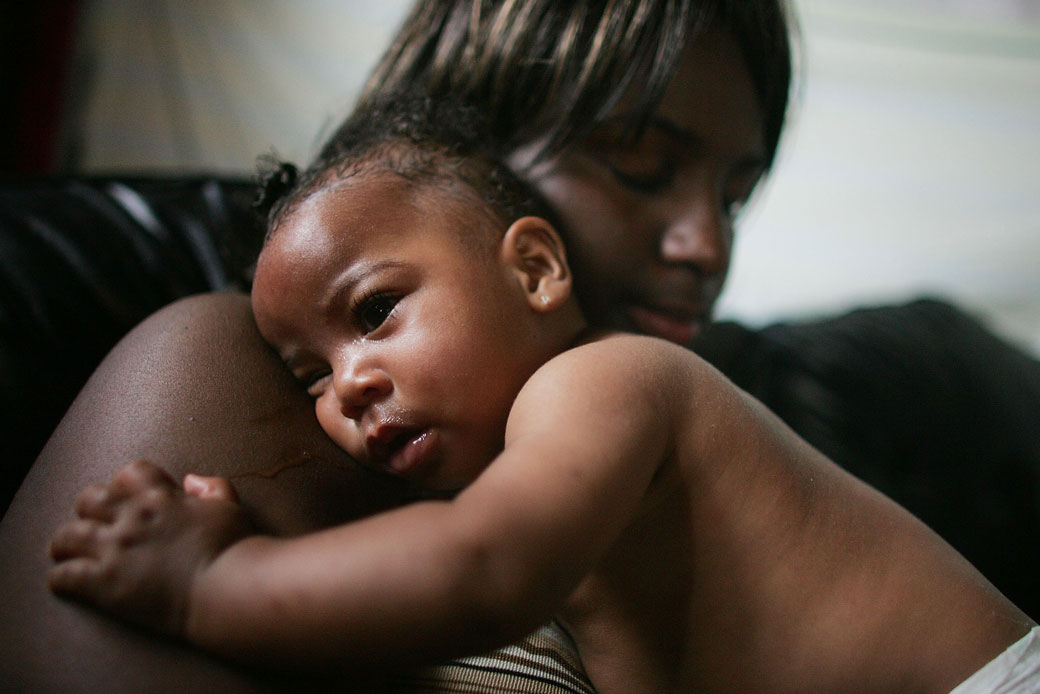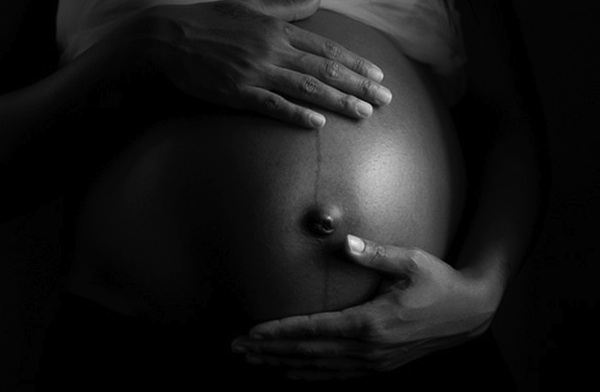Based on research surrounding racial disparities in New Orleans maternal and infant birth mortality, these stories are representational of a White woman’s and a Black woman’s experience giving birth.

Photo of Shanika Reaux holding her baby (Photo by: Mario Tama)
It was a warm and characteristically humid day in New Orleans, Louisiana. A 32 year old White woman, Anna, laid on the bed in her doctor’s office, anxiously watching the screen of her ultrasound. As she awaited the results, she reflected. She wondered how her husband’s day at the law firm was going, and how the babysitter was doing with her son. She made a mental note to send that baby gift to her college advisor, the woman whose support throughout undergrad helped her reach her current dream post-grad career. Anna listened in awe to a news story on the doctor’s office TV of “the Johnson family miracle triplets” and the attentive doctor who saved their lives during labor. She marvelled at the bouncing blonde ringlets and bright blue eyes of these babies. The miracle of birth, she thought. Moments later, Anna found out that she was in fact pregnant.
On that same warm, characteristically humid day in New Orleans, Louisiana, A 32 year old Black woman, Monica, took a pregnancy test at home. Her toddler screamed in the background, and she had 15 minutes before she needed to be dressed for work. Monica made a mental note to schedule her yearly physical, but with the stress of finding a doctor in New Orleans who respected her, unlike the last, she kept putting it off. According to Declercq et al.’s study, Monica shared these feelings with one in five Black women who have experienced similar poor treatment from clinicians due to their race. In this moment, Monica did not know she was at a sixty percent higher risk for the leading causes of maternal death compared to her White pregnant counterparts due to situations existing before her pregnancy. Through a lifetime of chronic racial discrimination involving hostile work environments and witnessing racialized police brutality, Monica’s cortisol levels had likely risen to dangerous levels, and put her at higher risk for hypertension, type two diabetes, and preeclampsia. What Monica did know, however, was the story of the white woman giving birth to healthy triplets, as she saw on the news that morning, followed by a news anchor congratulating their company’s owner on his spot on the most recent Forbes list. When Monica’s stick turned blue, there was no one there to warn her of the negative impacts of life-long race-based discrimination on herself and her pregnancy.
Anna floated through her pregnancy. Anna’s doctor reminisced on caring for Anna’s mother during her pregnancy, offered her a variety of prenatal vitamins to take, and suggested the best birthing classes in New Orleans. Cost was no concern, as Anna’s insurance covered the suggested vitamins ranging from fifteen to forty three dollars per bottle, and the New Orleans birthing classes ranging from fifty to two hundred dollars per class. One day, however, Anna came in complaining of frequent headaches and shortness of breath. Her doctor quickly ran tests and diagnosed her with hypertension. He applauded Anna for catching this early, as it could have endangered both her and the baby if left untreated. He sent her off with suggestions for lowering her blood pressure, and the two kept in touch consistently after that.
As Monica searched for a doctor, friends and family suggested she browse the internet for a “patient advocate” to bring along due to her past negative experiences. Unfortunately, they all came with out of pocket fees ranging from $100 to $500 per hour, and combined with the average cost of $375 for the visit itself, this hire was not realistic. Monica was not alone in these financial concerns, as Black women in New Orleans are two times less likely to have access to health insurance than White women. The doctor Monica settled on did not offer personalized suggestions, and based on his demeanor, Monica didn’t necessarily trust him. One day, however, Monica came in complaining of frequent headaches and shortness of breath. Her doctor shrugged it off and suggested she drink more water. This echoes the experience of many Black women in New Orleans, who note their clinicians’ delayed responses and tendency to not believe their concerns and symptoms. New Orleans resident Nicole Landum recalls her doctor suggesting she take Tylenol during her undiagnosed preeclampsia pregnancy, and “when I told him my head still hurt, he said to take more.” Sitting in that office, Monica thought back to her parents’ divorce. Her court issued social worker consistently reminded her that her role was to advocate for Monica in this divorce. Monica remembered the feeling of security knowing someone was there for her, and she had this woman to thank for the stable remainder of her childhood. Yet here, in this New Orleans doctors office, due to her race, she was left feeling undervalued, dismissed, and left to unsuccessfully advocate for herself.
Before Anna knew it, nine months flew by, and she was in labor. Her doctor had been keeping an eye on her blood pressure and taking the necessary precautions to ensure nothing more came of it. After some tough laboring, Anna gave birth to a healthy baby. Both mother and baby went home happy, without spending a dollar out of pocket for the $18,660 cost of labor and delivery.

Pregnant woman holding her stomach (Photo by: Hey Black Mom)
Before Monica knew it, she was in preterm labor. She rushed to the hospital with uterus pain and bleeding. Arriving at the hospital, the oddbs were stacked against Monica. Currently in Orleans parish, Black communities report more adverse birth outcomes than any other group, with this disparity continuing to widen. No doctor ever informed Monica that nationally, Black women are three to four times more at risk of birth related mortality than White women. No news channel ever informed Monica that Louisiana ranks sixth highest in Black maternal and infant mortality rates nationwide, nor of the higher than state average rates existing in New Orleans. Instead, Monica remembered the Johnson triplets from the news nine months ago, and looked forward to her own bundle of joy. At the hospital, an OBGYN examined Monica and diagnosed her with preeclampsia. Had her doctor caught this earlier, it likely wouldn’t have been a problem, but because he didn’t, Monica had major complications. Monica’s baby was delivered by C-section at a perilously low birth rate, and did not make it through the night. Monica suffered from too much bleeding, and died, unable to advocate for the lives of the countless women facing her preventable fate.
 NOLAbeings
Multimedia artist Claire Bangser created NOLAbeings as a portrait-based story project that marries...
NOLAbeings
Multimedia artist Claire Bangser created NOLAbeings as a portrait-based story project that marries...
 Data corner: Adobe Suite (create a PDF, social media graphic, presentation, edit a photo and video
Data corner is where you go to work with analytics and top tech skills. It takes on everything from PERL and SQL to Canva and Sprout Social.
Data corner: Adobe Suite (create a PDF, social media graphic, presentation, edit a photo and video
Data corner is where you go to work with analytics and top tech skills. It takes on everything from PERL and SQL to Canva and Sprout Social.
